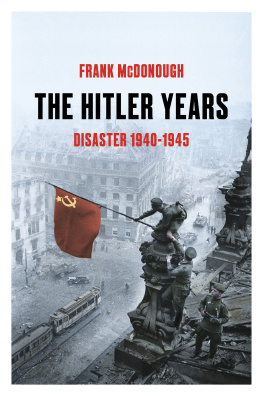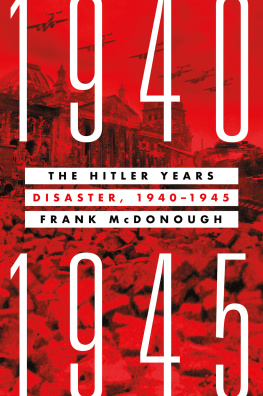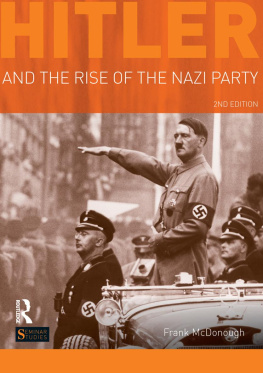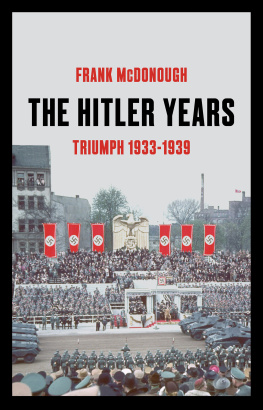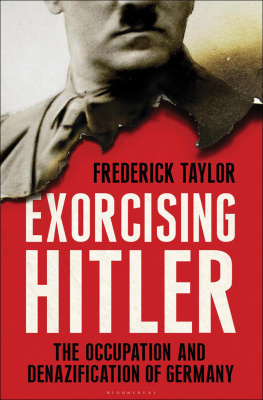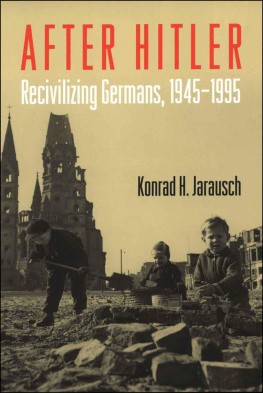THE
HITLER
YEARS

THE
HITLER
YEARS
VOLUME 2
DISASTER
19401945
FRANK M C DONOUGH
AN APOLLO BOOK
www.headofzeus.com
This book is dedicated to
my wonderful wife Ann,
the love of my life.
This is an Apollo book, first published in 2020 by Head of Zeus Ltd
Copyright Frank McDonough 2020
The moral right of Frank McDonough to be identied as the author of this work has been asserted in accordance with the Copyright, Designs and Patents Act of 1988.
All rights reserved. No part of this publication may be reproduced, stored in a retrieval system, or transmitted in any form or by any means, electronic, mechanical, photocopying, recording, or otherwise, without the prior permission of both the copyright owner and the above publisher of this book.
A catalogue record for this book is available from the British Library.
ISBN ( HB ) 9781789542806
( E ) 9781789542790
Picture research Juliet Brightmore
Maps by Jeff Edwards
Designed by Isambard Thomas, Corvo
Head of Zeus Ltd
58 Hardwick Street
London EC R RG
WWW . HEADOFZEUS . COM
CONTENTS
1940
BLITZKRIEG TRIUMPHANT
1941
WAR OF ANNIHILATION
1942
WAR AGAINST THE JEWS
1943
THE WEHRMACHT RETREATS
1944
LOSING BATTLES
1945
FUNERAL IN BERLIN
The German Invasion of Western Europe 1940

Operation Barbarossa: the Invasion of the Soviet Union 1941

The Landing Sites of the D-Day Landings, 6 June 1944

The Key Extermination Camps of the Holocaust

The Battle of Berlin, 1945

The division of Germany (left) and Berlin (right) after 1945

Over two volumes The Hitler Years tells the dramatic and horrific story of the Third Reich from 1933 to 1945. I adopt a chronological narrative framework and each chapter deals with a specific year in vivid detail.
The first volume, Triumph , covered the period from January 1933 to the end of December 1939. It charted the behind-the-scenes intrigues that brought Hitler to power, the destruction of democracy in Germany, the brutal removal of his political opponents, including the Night of the Long Knives and the evolution of Nazi anti-Jewish policy. It also revealed the caution Hitler adopted in domestic affairs and especially in foreign policy, and his instinctive ability to exploit shifting political events. In the end, I argued that Hitlers fundamental belief that only a war could bring Germany the living space it required in order to become a genuine superpower led directly to the conflict with Poland, France and Britain that began in September 1939.
This second volume, Disaster , covers the years from 1940 to 1945, when Germany went from the zenith of its military power to comprehensive defeat. Accordingly, the central focus of this book is on Germanys role in the Second World War, particularly the military progress of the war and the key turning points for Germany, but it also shows how Hitler, as well as the Nazi elite, German officers, soldiers, and the German people, reacted to the conflict; in particular how the Germans coped with the ferocious Allied air attacks from 1942 onwards, and the gradual collapse of German society towards the end of the war.
Another dominant strand of this volume is the horrific mass murder of an estimated 6 million Jews, which the Nazis referred to as their Final Solution of the Jewish question. It will be revealed how the Holocaust began with ghettoization in the German-occupied areas of Poland in 193940, then escalated to the mass shootings of Jews in the Soviet Union during the latter months of 1941, before leading to the creation of purpose-built extermination camps, eventually reaching its most murderous period in 1942, during Operation Reinhard.
Contrary to popular belief, historical knowledge of the Third Reich is by no means complete. New details on specialized areas emerge continuously and general histories need constantly updating. New general studies on this subject are therefore thoroughly warranted. Hitler biographies appear even more regularly, but they fail to explain the fact that there is no comprehensive collection of sources relating to how Hitler exercised his power as Fhrer, because near the end of the war he ordered the destruction of his most confidential private papers. Indeed, Hitler biographies are not really about Hitler at all, but record what other people thought about him. Some are general histories pretending to be biographies. It is really a distortion of history to see the Third Reich through the narrow prism of Hitlers mind. It must be understood that Hitler was one important ingredient in the historical events which unfolded, but he was ultimately powerless to control those events.
Adolf Hitler presented the conflict that began in September 1939 as a war of national defence forced upon Germany by Jewish wire-pullers in Britain and France, who were determined to prevent Germany gaining living space. The same argument was used to justify the German attack on the Soviet Union in June 1941: again Hitler presented it as a preventive war to stop the Jewish-inspired Bolsheviks from attacking Germany. The decision to declare war on the United States in December 1941 was portrayed in a similar way. On that occasion Jewish wire-pullers had apparently forced President Roosevelt to join the Jewish worldwide conspiracy. A great majority of Germans accepted Hitlers totally false explanation of why Germany had been forced to go to war.
Two separate military conflicts are at the centre of events from 1940 to 1945 examined in this book. First, the epic German-Soviet War, which ran continuously from the beginning of Operation Barbarossa on 22 June 1941 to the end of the war on 9 May 1945. Four out of every five German soldiers who died in the Second World War were killed by the Red Army. Second, the separate war Germany fought against the British and French empires and the United States. The key events of this struggle were a protracted naval war; the war between Germany and the Anglo-French alliance in 1940, which lasted just six weeks; the German bombing war over Britain, particularly in 1940; the Anglo-American bombing war against Germany from 1942 to 1945; the key battles between Germany and Italy against the Anglo-American Allies in North Africa, in southern Italy, and in the period following the D-Day landings on 6 June 1944, ending in victory for the Allies in Western Europe in May 1945.

